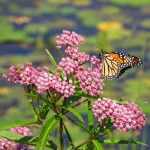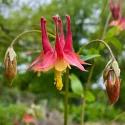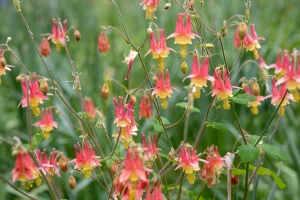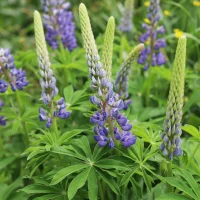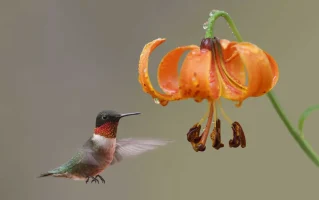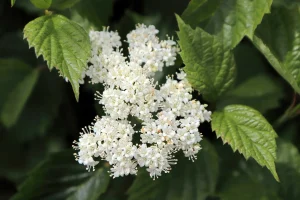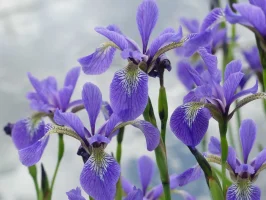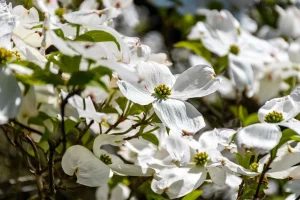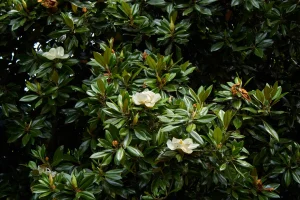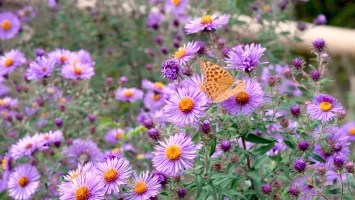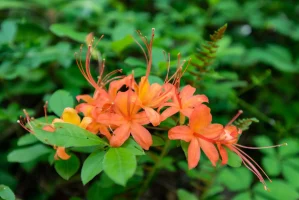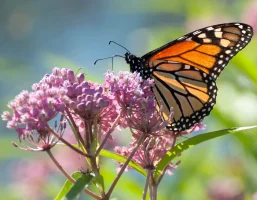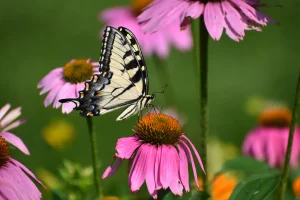Highlights
If you’re looking for a stunning entryway or statement shrub, native rhododendrons are a stellar choice. These stately evergreen beauties grow from 4-20 feet tall (depending on the species) with glossy leaves no matter the season. In the spring, small bouquets of five-petal flowers open and attract early pollinators. They like part sun to shade, and after the first year are happy with just rain. Plant a few over a weekend and they can last for decades. Scroll down to see what rhododendrons are native.
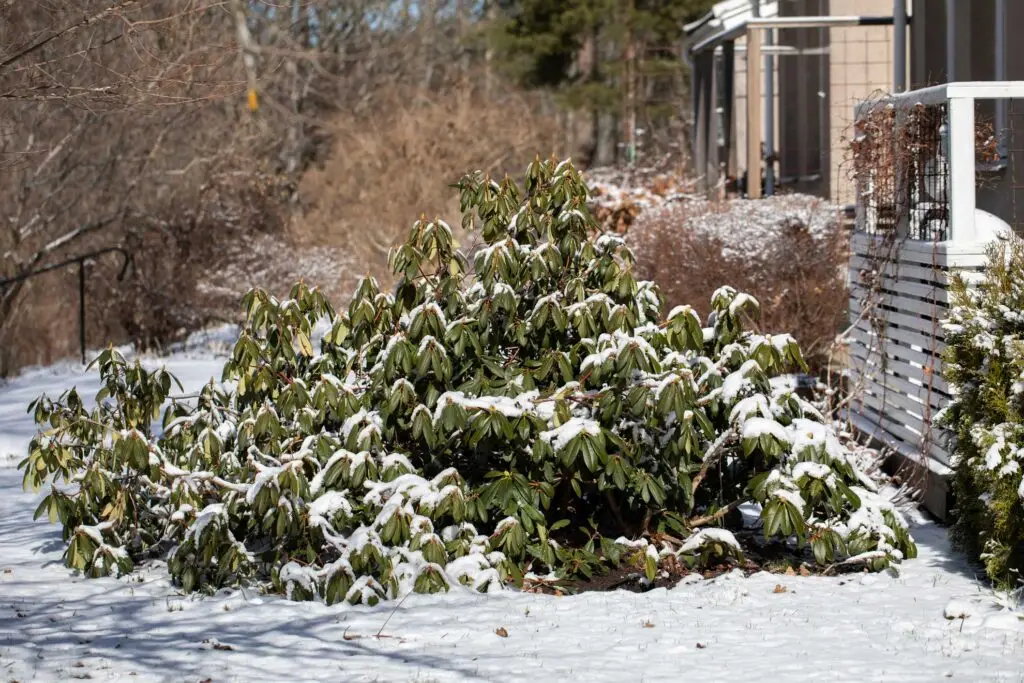
Dig Deeper
Explore the history, types, and where to plant native rhododendrons
Table of Contents
When it comes to choosing plants for your garden, native plants are always a great choice. They have evolved to thrive in their home area, they offer food and homes for birds, butterflies, and pollinators, and they require minimal care.
Native rhododendrons are excellent shrubs to plant in highly visible places, like front walkways and in front of homes. In this article, we’ll take a closer look at native rhododendrons and why they’re a great addition to any garden.
Native vs. non-native rhododendrons
The world is filled with rhododendrons—there are 1000+ species found across the globe! 90% of the world’s rhododendrons come from southeastern Asia, including the Himalayas, Tibet, western and central China, and the Philippines.
What rhododendrons are native to North America?
The Rhododendron genus includes 28 species native to North America, just three of which are evergreen. These three evergreen shrubs are the plants normally called ‘rhododendrons.’ Scroll below to meet all three. These plants are beautiful, help butterflies and birds, and require minimal care over the years (especially compared to lawns).
Now you’re probably asking: what are the other 25 native plants in the Rhododendron genus called?
Most native plants in the Rhododendron genus go by the common name azalea
17 of the 28 plants in the Rhododendron genus are normally known as azaleas. Visit our Beginner’s Guide to Native Azaleas to meet them all. Here’s the basic difference between the two names:
Azalea vs. Rhododendrons — what's the difference?
Both shrubs flower. Both plants are in the Rhododendron genus. But to keep it super simple (and not go too plant nerd):
- Rhododendrons are evergreen (keep their leaves year-round)
- Azaleas lose their leaves in the winter (deciduous)
Ok, now that we know a little bit about confusing Rhododendron naming, let’s talk about planting native vs. non-native rhodos.
What’s the difference between non-native and native rhododendrons?
There are a few differences between non-native and native rhododendrons:
- In general, native rhododendrons are smaller and more compact than their non-native counterparts
- Native rhododendrons are much better suited to thrive in North America’s weather and climate; their DNA includes characteristics that have helped them thrive here for thousands of years
- Only rain is needed for native rhododendrons to thrive; non-native rhodos sometimes need specialty watering and care
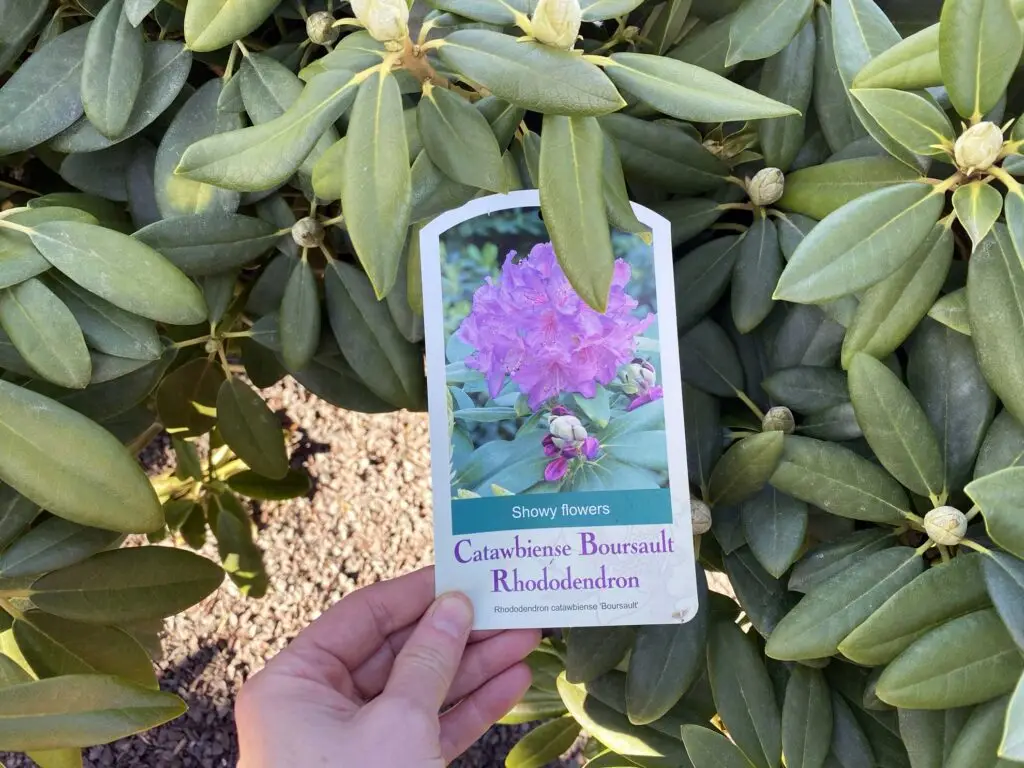
One last trivia fact to share, before we meet the native rhodos.
What does the name rhododendron mean?
According to the American Azalea Society, “Rhododendron is a word of Greek origin, with rhodos meaning ‘rose’ and dendron indicating ‘tree.'” Wow, what a great Latin name!
Now, let’s meet the three native rose-trees found in North America.
Rhododendrons native to North America
The three rhododendrons native to North America include:

1.
Carolina Rhododendron
Rhododendron carolinianum
Carolina Rhodos are found from Florida and Alabama to Tennessee and North Carolina in mountains and plains. They are shorter shrubs that grow to around 4 feet tall.
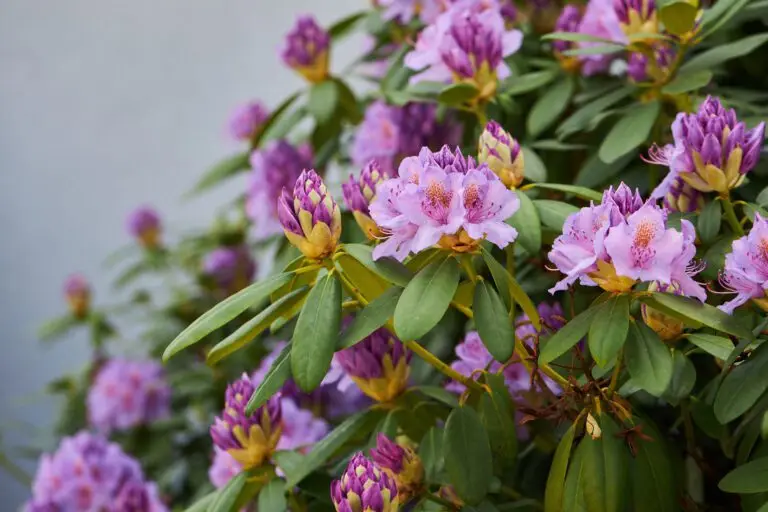
2.
Mountain Rosebay (or Catawba Rhododendron)
Rhododendron catawbiense
Mountain Rosebays are native from Virginia south to Georgia and west to Alabama, Kentucky, and West Virginia. They have large rose to purple-lilac colored flowers (colors vary from plant-to-plant.)
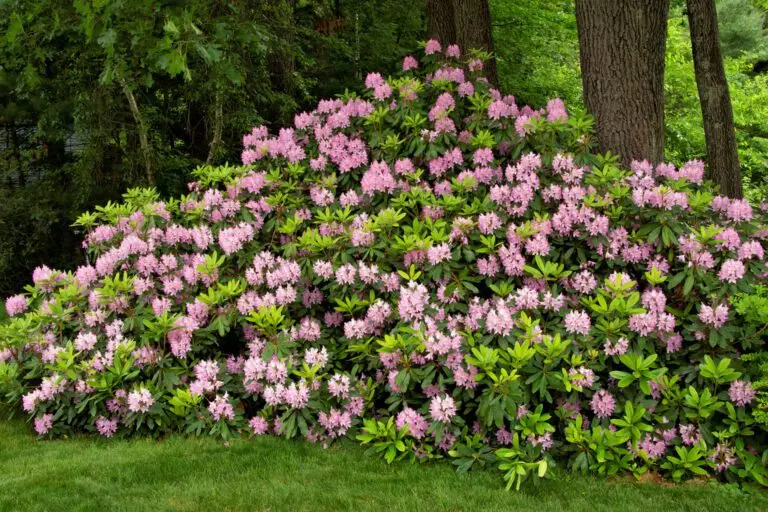
3.
Rosebay Rhododendron
Rhododendron maximum
Rosebay Rhodos are tall (hence their ‘maximum’ Latin name)—they can grow 10-20 feet wide and tall. Rosebays are native to North America from Ontario and Nova Scotia south to Ohio, Alabama, and Georgia, with a concentration in the southern Appalachian Mountains.
Historic Rosebay Rhodo interlude…
American writer and thinker Henry David Thoreau wrote admiringly about native Rosebay Rhodos used in landscaping in his journal from June 4, 1853 (The Plant Native’s bolding):
“The date of the introduction of the Rhododendron maximum into Concord is worth preserving…They were small plants, one to four feet high, some with large flower-buds, twenty-five cents apiece; and I noticed the next day one or more in front of every yard on each side of the street, and the inhabitants out watering them. Said to be the most splendid native flower in Massachusetts.”
Buying a native rhododendron today will be more than 25 cents, but it’s lovely to know planting them in front yards goes back 150 years. (And we do agree with Thoreau on many things, including Rosebay Rhodos being splendid native flowers.)
Now that we’ve met the three native rhododendrons, let’s talk about why and where to plant these beautiful shrubs.
Why plant native rhododendrons?
There are many benefits to planting native rhododendrons:
Native rhodos help wildlife
Native rhododendrons provide habitat and food for birds and insects. Their blooms also support pollinators like bees and butterflies, which depend on flowers for pollen and nectar.
Rhododendrons are beautiful
Native rhododendrons are known for their stunning blooms, which come in a range of colors from white to pink to red. They are also evergreen, which means no matter the season or weather, they will always have glossy leaves.
Planting native rhododendrons saves time and money
Native rhododendrons are low-maintenance plants that require little watering or fertilization once established. They are also relatively pest and disease-resistant. Compare this low-key level of care to how much time and money it takes for lawns and get some time (and money) back!
How to grow native rhododendrons
Growing native rhododendrons is easy if you follow a few basic guidelines. Here are a few tips to get you started:
Soil and sun requirements
Native rhodos are understory shrubs: they are found underneath taller trees in nature. To mimic this, plant native rhododendrons in partial shade. Native rhododendrons can tolerate full sun—when they are in cooler climates, especially when kept moist.
Native rhodos prefer acidic soil with good drainage. In nature, acidic soil is most often found near evergreen trees (the needles drop, and make the soil acidic.) If you have a place already that’s nearby an evergreen tree, plant a native rhododendron there.
How to plant
Plant native rhododendrons in the fall or early spring. Dig a hole that is about twice as wide as the root ball and about as deep. Mix some organic matter into the soil to help it retain moisture. Water the plant well after planting.
Rhododendron care
Native rhododendrons require little maintenance once established. Water the plants regularly during the first year to help them establish their root systems. After that, native rhododendrons should be able to survive on their own with just rain.
What to plant with rhododendrons
There are so many native plants that look great, like acidic soil, and pair nicely with native rhododendrons. Here are some stellar native combinations that look gorgeous.
Shrubs and trees to pair with rhododendrons
A great trio of native plants is rhododendrons + azaleas + mountain laurel. (Here’s a short overview of how these three plants differ.) Delicious Highbush Blueberries and serviceberries are also native and enjoy acidic soil.
Flowers to pair with rhododendrons
False Blue Indigo and native Wild Columbine are two gorgeous native flowers that thrive in acidic soils and part-shade environments.
Let’s all plant some native rhododendrons
Native rhododendrons are a fantastic choice for gardeners who want to support local ecosystems, do minimal gardening, and love a bloom-filled yard. With their stunning flowers, year-round evergreen foliage, and easy-to-grow nature, these plants are always a garden highlight. Planting native rhododendrons helps preserve the biodiversity of your local community while also creating a vibrant and thriving garden that you can enjoy for years. Add some native rhododendrons to your garden today to sit back and enjoy fuss-free beauty year-round.
Next steps and resources:
There are lots of well-known plants that have native options available. Explore our beginner guides to native favorites:
Sources
- Missouri Botanical Garden, Rhododendron catawbiense
- Mount Cuba Center, Rosebay Rhododendron
- Native Plant Trust, Rhododendron carolinianum
- NC State Extension, Rhodendron maximum
- Rhodyman, Native Rhododendrons & Azaleas of North America
- Harris, Marjorie. Botanica North America: The Illustrated Guide to Our Native Plants, Their Botany, History, and the Way They Have Shaped Our World. (2003), 58-61.
- Nelson, Gil. Best Native Plants for Southern Gardens: A Handbook for Gardeners, Homeowners, and Professionals. (2010).
